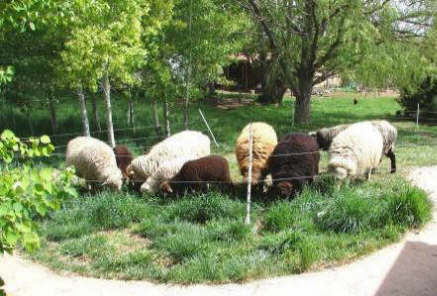 Whole
New Concepts
Whole
New Concepts
Training and Development Services for Today's World
See the Big Picture ~~ Respond to Change
Become Sustainable
Holistic Management
Family Farms & Ranches
Sustainable Agriculture
Business Development
Local Food
Beginning Farmers
Nature's Lawn Mowers
by Cindy Dvergsten, Holistic Management Educator
Have you ever experienced a time when suddenly a light bulb comes on? Such was the case for me while on a ranch tour in 1995 near Rocky Mountain House, Alberta Canada. Randee Halladay was showing us around their home when she noted that their lawn mower had not been used for a number of years. She explained how she allowed their cattle to do the lawn mowing for her, saving both time and money.
Although at the time I did not have grazing animals, the idea of “natural lawn mowers” lodged in my mind. I am happy to say now that our gas powered lawn mower has been idle for several years.
Controlled with easy to move temporary electric fencing, our Navajo-Churro Sheep are ideal for working in small nooks around the home and yard at Arriola Sunshine Farm.
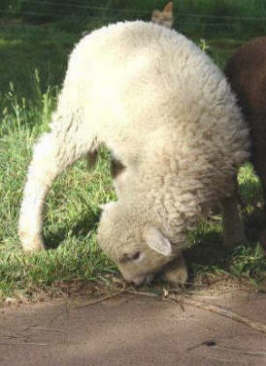
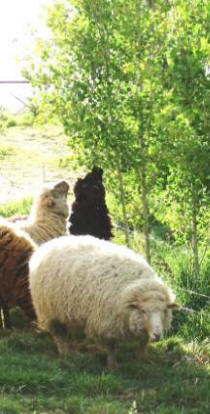 Our sheep also enjoy trimming the trees, especially the aspen and
weeping willow. Not only that, but the lambs are adept as edging
only the sidewalk!
And all of the grass is converted
into natural fertilizer (manure).
No clippings to mess with!
Our sheep also enjoy trimming the trees, especially the aspen and
weeping willow. Not only that, but the lambs are adept as edging
only the sidewalk!
And all of the grass is converted
into natural fertilizer (manure).
No clippings to mess with!
Multiple Benefits of Grazing Animals
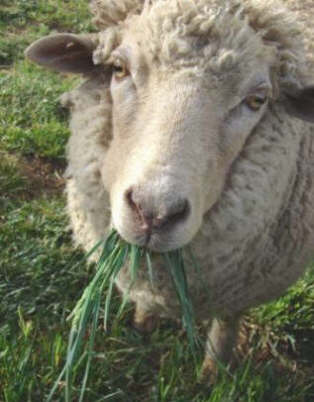
The benefits of using natural lawn mowers go beyond saved time and money. The ¼ acre of yard and miscellaneous areas around the house we graze provides approximately 1500 pounds of grass forage. This is enough forage to produce about 40 pounds of lamb meat and several pounds of wool with a retail value of approximately $345.00 USD (2008 prices).
We get approximately 200 animal days of grazing from our yard area. During this time the sheep deposit about 600 pounds of manure. This amount of manure contains 10 pounds of nitrogen and 8 pounds of phosphate that are readily available for plant growth. This would be similar to the amount of fertilizer recommended for a spring treatment for average lawn care.
According to Consumer Reports (http://www.consumerreports.org), small, two-stroke engines used in conventional lawn-care equipment are big polluters. Mowing a lawn one hour per week for a summer consumes only 10 gallons of gas, but releases an average of 148 pounds of carbon-dioxide emissions per year. Furthermore, one hour on an average riding mower emits roughly the same amount of NO2, one of the key ingredients in smog, as driving a very clean new car for 75,000 miles.
Perhaps the most important function our sheep perform is their role in carbon sequestration. Grass removes carbon from the air through photosynthesis. Grazing animals like sheep convert the grass into manure which is readily broken down into soil organic matter and humus by soil organisms. Sequestration of soil carbon is extremely important to reducing the amount of green house gasses. According to the Soil Carbon Coalition (http:// www.soilcarbon coalition.org), most of the biosphere's carbon is in the deep layers of the ocean while the next largest “pool” of carbon is found in the soil. More importantly, once carbon is in the soil it stays there for an average of 35 years.
In 2001, the Soil Science Society of America drafted a position paper that included this statement: "Worldwide, SOC [soil organic carbon] in the top 1 meter of soil comprises about 3/4 of the earth's terrestrial carbon; nevertheless, there is tremendous potential to sequester additional carbon in soil. For example, many cropland soils of the United States have lost as much as 50% of their original SOC due to the effects of land clearing and tillage. Such conventional farming practices 'burn' SOC just as we burn fossil fuels today. However, in the case of SOC this historical decline can be reversed, which is not the case for fossil fuel reserves." (See www.soils.org/pdf/pos_paper_carb_seq.pdf.)
The Carbon Cycle is Aided by Grazing Animals
Within 10 days the manure left by the sheep in our yard is gone. Night crawlers, a type of earthworm, eat the manure and carry also the manure 3-4 feet down into their burrows to supplies food for their young.
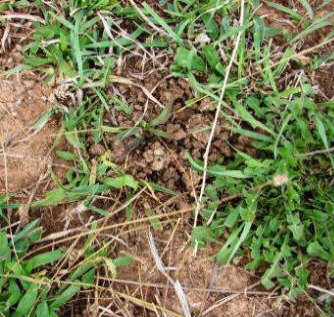 The
photo to the right shows “casts” left on soil surface from where the
Night Crawlers burrow into the ground. Notice the absence of manure
and the new growth occurring in the grass plants.
The
photo to the right shows “casts” left on soil surface from where the
Night Crawlers burrow into the ground. Notice the absence of manure
and the new growth occurring in the grass plants.
From the land's view point, grazing is a function of time.
Holistic Management Planned Grazing helps us to be in the right
place, at the right time, for the right reason with our sheep.
In nature grazing animals help carbon cycle naturally back into the
soil.
When grazing occurs within the limits of natures boundaries, grazing
animals like our sheep become a valuable tool of management.
And in this case, sheep are managing our lawn.
Food for Thought about our Carbon Footprint
Where the earth stores carbon:
-
Oceans: 38,000 gigatons C (stable, average turnover of a C atom is about 100 years)
-
Soils: 1600 - 2400 gigatons C (average turnover about 35 years)
-
Atmosphere: 800 gigatons C (average turnover 5 years)
-
Biomass: 600 gigatons C (average turnover 10 years)
Source: Soil Carbon Coalition. See www.soilcarboncoallition.org for interesting information and discussion about how to increase soil carbon.
About lawnmower usage:
- 54 million Americans mow their lawns each weekend.
- 5 percent of the nation's air pollution comes from traditional gas-powered lawn mowers.
- 80 pounds of carbon dioxide is released into the atmosphere each year by the average gas-powered mower.
- 800 million gallons of gas are consumed each year by gas mowers.
Source: Environmental Protection Agency and People Powered Machines
World Fertilizer Prices Soar
World fertilizer prices, especially, rose sharply in 2007 then skyrocketed -- off the chart -- from January to April 2008 according to a report by the International Center for Soil Fertility and Agriculture. For example, the price of Di-ammonium phosphate increased by five times over the past 15 months from about US $252 per metric ton in January 2007 to about $1,230 per ton over the past 3 by May of 2008. DAP is a common fertilizer containing 18 pounds of nitrogen and 46 pounds of phosphate per 100 pounds of fertilizer product.
Source: EurekAlert at www.eurekalert.org/pub_releases/2008-05/i-wfp052308.php
Notice: Copyright©2008 by Cindy Dvergsten, Whole New Concepts LLC. Permission must be granted in writing for use of this article by contacting Whole New Concepts LLC.
Topics Covered In
This Article Include:
Carbon Footprint
Holistic Grazing Planning
Natural Lawn Care
Global Climate Change
Sheep Production
Fertilizer Use
Article Links
Irrigation Water: Handle with Care.
When The Thistle Wilts at Fat Sheep Farm
Other Links
Our Distance Learning & Mentoring Programs
Consulting & Facilitation Services
Contact Us For More Information
